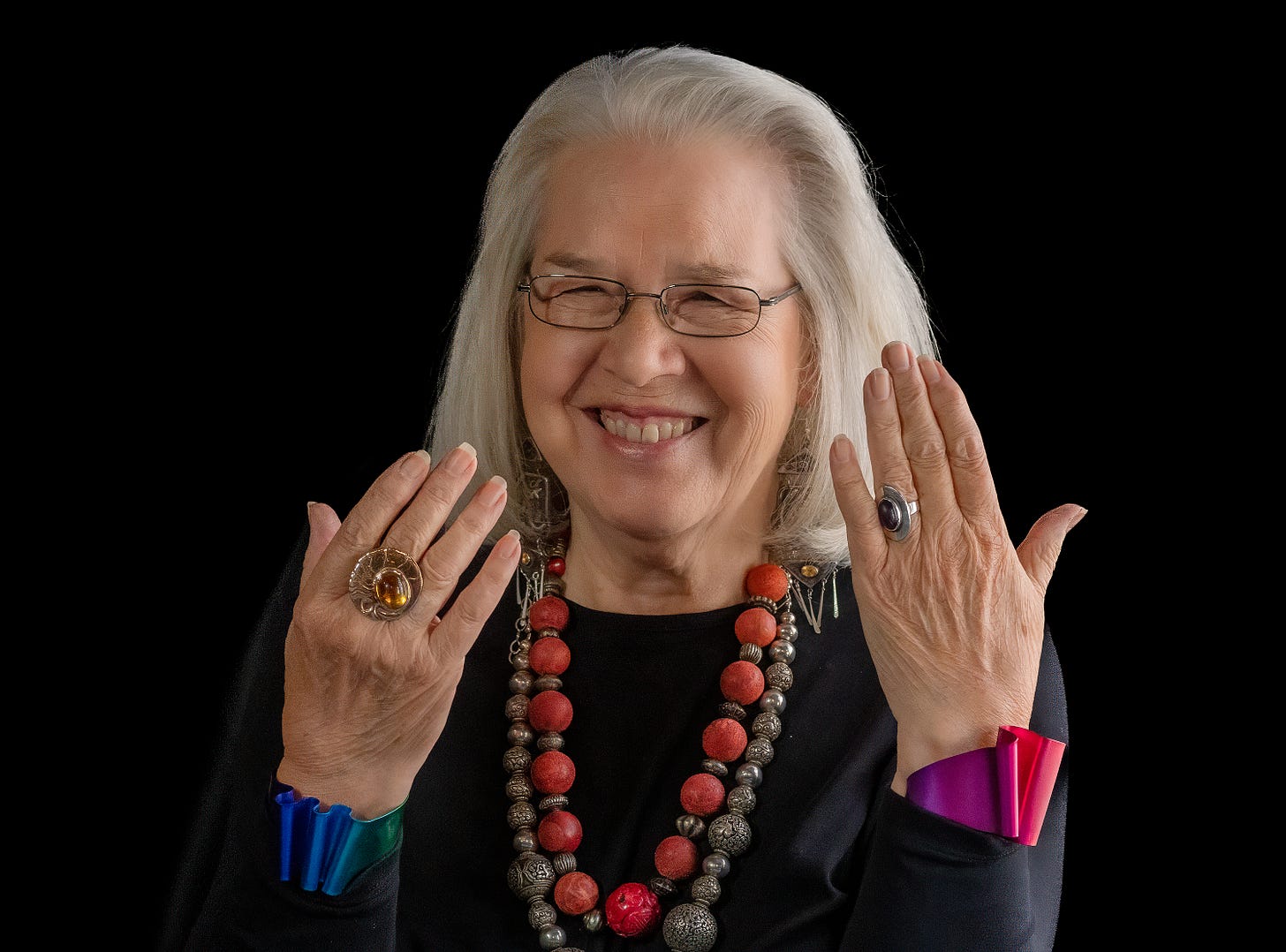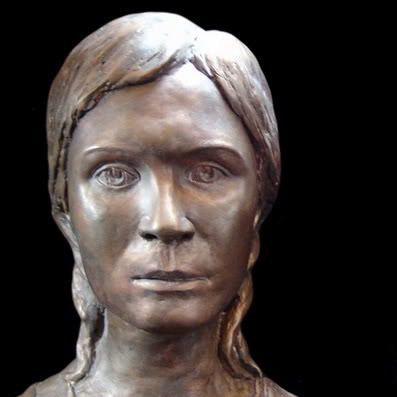Origin stories
A pair of artists start a festival to restore salmon runs and three scholars working over three centuries discover the common root of Indo-European languages. Plus a visit to the zoo.
PROFILE

Celebration, education, restoration: the story of Wild Olympic Salmon
ONE OF THE FIRST THINGS that Sara Mall Johani wants you to know about her is that she’s Estonian. The small Baltic country is known for its independent spirit—they resisted both Russian and German occupiers in the last century—as well as its democratic values and rooted cultural traditions. I can attest to the “independent” part. I once tried unsuccessfully to persuade Sara, a seventy-something with chronic back pain, not to climb on the roof by herself to sweep leaves.
Estonia is also the most biologically diverse country at its latitude. So perhaps it should be no surprise that Sara, together with her late husband Tom Jay, used their art to help propel a movement to save the salmon runs on Washington’s Olympic Peninsula, where we both live. It started as a festival, centered on salmon art, called Wild Olympic Salmon.
The art came first. Tom and Sara created bronze sculptures as well as jewelry and other artworks for over six decades. Sara is still supervising castings and doing the laborious finishing work on some pieces. Their home, which they built and where Sara still lives, lies down a gravel road, parts of it running through a recently clear-cut forest, in Chimacum, a community largely devoted to farming. Tom is known and beloved for his large-scale salmon and raven sculptures while many of Sara’s pieces fit on bookshelves in the gallery she recently restored on their property. Last summer, she agreed to include several of her and Tom’s sculptures at an exhibit of photographs by Brian Goodman and me entitled Outside In.
I met Tom ten years ago, shortly before we moved to Port Townsend. At the workshop, I was fortunate to observe him pouring bronze into a mold on one occasion and on another to watch him polish a 300-pound sculpture of a Coho Salmon. But I only got to know Sara after he died in 2019. She wanted to publish a book on the origins and history of Wild Olympic Salmon and heard that I might be able to help. Curious about that project and her, I agreed to meet.
Sara showed up at my house with a box of rumpled papers. The pages had tattered pieces of text and pictures taped to them. I quietly sighed. This was just the kind of book rescue project that I had tried to avoid. But I liked Sara. Her views were firmly held but free of anger, and leavened by a ready laugh that lit up her face. She also possessed a curiosity about a multitude of subjects.
Despite the unruliness of the box of papers, it emerged that Sara’s digital files were well organized and I was able to assemble and design the small book quickly. The material was also fascinating and right up my alley. An organization of artists that celebrated salmon morphed into an education project and ultimately into a community-wide effort to restore the Chum Salmon run in Chimacum Creek. As I write, the Chum are pushing their way up the stream to dig redds—shallow holes in the creek bottom—to lay their eggs. And Chimacum Creek was just the beginning. The successor to these efforts is an organization, North Olympic Salmon Coalition, that has conducted multimillion-dollar restoration projects.
Volunteers from Wild Olympic Salmon days still show up after thirty years on designated weeks to count the fish and find and mitigate obstacles to their return. A former nurse told me she that first encountered Wild Olympic Salmon through an education project called Dragon Tracks. Sara noticed that that the geographical shape of the county resembled a dragon, and she resurrected a dragon story told by one of the local tribes. Tom cast bronze dragon feet as destinations in a wild treasure hunt with salmon-oriented clues to their whereabouts. The former nurse spent weekends with her two young daughters hunting down the dragon tracks, which inspired her to become a fish biologist for the state fish and wildlife agency.
We published the book and featured it at our joint exhibit. The title aptly captures Tom and Sara’s philosophy about the natural world. It’s called Mine, Yours, Nobody’s.
To obtain copies of the book, write Sara at housojay@olympus.net. And visit Tom and Sara’s website.
WHAT’S FASCINATING BARBARA?




Two knights and a lady: an origin story
If European languages share a common ancestor, who was that ancestor? Born three centuries apart, two men and one determined woman were key to finding an answer.
By Barbara Ramsey
OUR FIRST KNIGHT, Sir William Jones, was of born in 1746 to a family of Welch scholars. He became one himself at Oxford, where he was known for his erudition in the study of languages, history, and law. Interested in politics, he also ran unsuccessfully for parliament and helped Benjamin Franklin agitate for American freedom in Paris. In 1783, he was sent to India to take up a position as a judge on the British Supreme Court of Calcutta.
Once there, Jones studied Hindu astronomy and the ancient legal system of pre-Islamic India. Always fascinated by languages, he also studied Sanskrit, analyzing the Vedas with Indian pundits. And in 1786, he became convinced that Greek, Latin, and Sanskrit—three of the eight languages he’d become fluent in—had all sprung from a common source. Others had seen these connections, but Sir William was the first to create widespread interest in the source of this protolanguage. Where was it spoken? Who were its speakers?
This is mind-blowing to me. An agent of the British Empire in the 1780s promulgated the idea that Europeans and Indians shared a root language? I did not see that coming.
Fast forward about 150 years to our next scholar, Marija Gimbutas. Born in Lithuania to doctor-parents in 1921, she grew up among the intelligentsia, surrounded by writers and musicians. At university, Gimbutas married and had her first daughter while studying linguistics, archeology, and ethnology. But war interfered. In 1943 she carried “her thesis under one arm and her baby under the other” as she fled the invading Soviets.
In 1950, after postdoc work in Europe, Gimbutas was invited to Harvard as a lecturer in anthropology and a Fellow of the Peabody Museum. Sounds pretty great, right? But Harvard was less than hospitable to women and refugees, she later recounted. She was given an “office” in a small room in the basement and no salary for the first several years there. How’s that for Ivy-League collegiality?
Of course that didn’t stop her. In 1963, UCLA hired—and paid—her as a Professor of European Archeology. Over the following years, Gimbutas directed major excavations throughout Greece and Macedonia and began to synthesize a number of new ideas about early European history. In particular, one ancient culture fascinated her. She called them Kurgans, after the Russian word for burial mound, because they often buried their dead in pit graves topped by earthen mounds.
The Kurgans were horse-riding nomadic pastoralists who lived about five thousand years ago on the western steppes north of the Black Sea. They herded sheep, goats, and cattle at a time when many people in Europe, the Middle East, and Asia were becoming sedentary agriculturalists. Kurgans were among the first to develop the wheel and used two-wheeled carts and four-wheeled wagons—some were even buried with them.
Kurgans had a high protein diet, unlike the agriculturalists of their time. The ate their herd animals and also drank their milk—archeologists have found milk by-products on the teeth of both adults and children. (Thank god they didn’t have dentists or we might not know this.) And because they herded on horseback, they could manage three times as many sheep as pedestrian shepherds.
The grass-covered steppes were inhospitable to farming, but mounted pastoralism transformed them into a vast food resource. The Kurgans converted a caloric desert into a kind of Neolithic Diary Queen, enabling them to enlarge their population. Gimbutas was aware of evidence that they had spread from their ancestral homeland into western Europe, but there was a great deal of argument about whether this spread was peaceful or violent. She came down firmly on the side of war. Gimbutas envisioned Kurgans as a mounted, armed people who introduced a whole new language called Proto-Indo-European (PIE), mainly through migration and conquest.
Earlier scholars had analyzed the similarities among Indo-European languages, from the Celtic languages of the British Isles to the Indic languages of Bangladesh. Time and again, they found similar nouns and verb forms that were absent from the languages of Africa, the Americas, eastern Asia, and the Pacific. Gimbutas believed the Kurgans were the key to the mystery of the origins of Proto-Indo-European and she had the archeological chops to support her claim.
But Gimbutas was also a controversial figure. She posited that matriarchal societies had predominated prior to the Kurgan invasions, a theory that was popularized by second-wave feminists in the 1970s. With debatable evidence to support this idea, some scholars cast doubt on her work.
Enter the second knight of our story, Lord Colin Renfrew. Still alive today at age 87, he was born into British nobility and educated at Cambridge (not Massachusetts, as he likes to point out). Well known as an archeologist and paleolinguist, he worked with Gimbutas on a number of archeological sites and they had a long-standing collegial relationship. But they strongly disagreed about the origins of PIE speakers.
Renfrew believed that PIE originated in Anatolia, not north of the Black Sea, and was first spoken by agricultural peoples. He also believed that the PIE languages spread by diffusion, not migration, and was largely peaceful. For more than forty years, he promulgated these theories, persuading many other scholars. And there was a lot of evidence to support his views, at least until paleo-genetics—the study of the DNA in skeletal remains of prehistoric people—came along.
The Kurgans are now considered part of a larger group of mounted pastoralists called the Yamanaya, whose DNA, obtained from burial mounds, has been studied and compared to both other prehistoric cultural groups and present-day human groups. As it turns out, many living Europeans, especially northern Europeans, share a significant proportion of their genes with the Yamnaya, and relatively little with the ancient agriculturalists in the rest of Europe. For example, the Neolithic farmers who built Stonehenge contribute very little to the genetic make-up of most English people. Steppe-herder genes predominate.
Of the many curious twists and turns to the Yamnaya DNA story, I find one especially intriguing. We now know that the risk of developing multiple sclerosis (MS) is increased by certain genetic markers, especially among people of European descent. These genetic markers are first found in the archeological record in Yamnaya remains. Why would that be?
These specific genes are part of our immunological response system, which goes a bit haywire in MS, causing the body to attack its own nerve cells. But these genes also become active in people infected with the anthrax bacteria. Remember anthrax? The germ terrorists put into envelopes? Well, in the natural world, anthrax frequently infects grazing herbivores such as sheep, the same ones that the Kurgan/Yamnaya herded. The MS genes were adaptive, protecting the animal herders.
Gimbutas died in 1994, too soon to have been cheered by the support of paleogenetics. But there is now a yearly memorial lecture given in her honor at the University of Chicago. In 2020, the lecture was given by Lord Colin Renfrew, who was there to acknowledge that Marija Gimbutas had been right all along.
PICTURE & WORDS
AN OLD FRIEND once told me about taking his five-year-old grandson to an amusement park. When my friend suggested a ride on the ferris wheel, the boy balked. “You don’t understand, Grandpa,” he said. “I’m a sensitive boy.” I thought of that story when I saw this young fellow recently at Woodland Park Zoo in Seattle. I’m not sure what was on the other side of the glass just then—the sign suggests a tiger—but whatever it was, the glass wasn’t thick enough for this child. I love his mother’s firm grip and her seasoned look of calm. She knows her sensitive boy.
I like photographs that watch people watching. This one was shot with a 28mm Leica Q3.






Inspired to learn more about Gimbutas.
A great on-going story about great people.